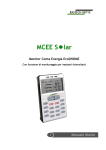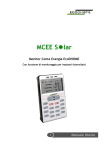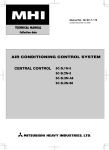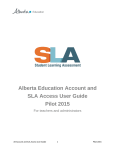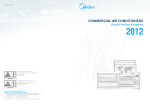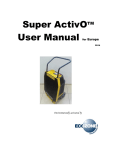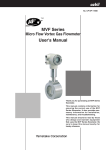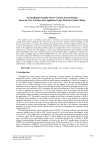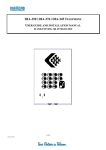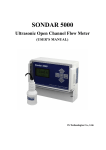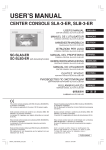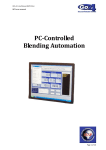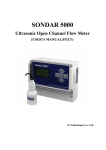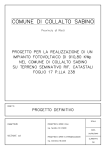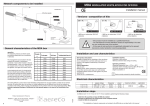Download AIR CONDITIONING CONTROL SYSTEM TECHNICAL
Transcript
Manual No. ’06 . SC-T - 111 TECHNICAL MANUAL Collection data AIR CONDITIONING CONTROL SYSTEM CENTER CONSOLE SLA-3-ER (SC-SLA3-ER) SLB-3-ER (SC-SLB3-ER) - 3- CONTENTS 1. MODEL USED ALL SUPER LINK RELATED MODELS ................................. 1 2. SPECIFICATIONS ........................................................................................... 1 3. ACCESSORIES ............................................................................................... 1 4. EXTERNAL VIEW ............................................................................................ 2 5. INSTALLATION ............................................................................................... 2 6. FUNCTIONS .................................................................................................... 4 7. ELECTRIC WIRING ......................................................................................... 9 8. SELECTING A NEW PULSE UNIT .................................................................. 10 These technical manual cover Center Consoles SLA-3-ER and SLB-3ER. Concerning other air conditioning control systems, see page 675 in Part 5 (Air Conditioning Control System) of the ’06 TECHNICAL MANUAL KX-4 - 1- Center Console SLA-3-ER, SLB-3-ER 1 MODEL USED ALL SUPER LINK RELATED MODELS Name Center Console SLA-3-ER SLB-3-ER Model Remark SC-SLA3-ER SC-SLA3-ER If the SLA-3-ER and SLB-3-ER is buried, it must be installed in a separately sold box (SLA3R-BX). 2 SPECIFICATIONS Model SLA-3-ER, SLB-3-ER(9) Item 0 ~ 40 °C Ambient temperature during use Power supply 1 Phase 100V/200~240V 50Hz/60Hz 17 W Power consumption External dimensions (Height⳯Width⳯Depth) Net weight 162 mm ⳯ 240 mm ⳯ 110 mm 2 kg Maximum number of connectable units (Indoor units) Maximum 48 units/system 3 systems = 144 units Outputs Inputs LCD touch panel(4), (5) SL (Super link) Signal inputs (2) Gas, Power pulse input Fire signal input (2) Demand signal input(2) Simultaneous operation output Simultaneous error output Use with other central control units Notes (1) (2) (3) (4) (5) (6) (7) (8) (9) (10) Color LCD, 7 inches wide 3 systems 8-point pulse width 100 ms or more 1 point non-voltage a contact input continuous input (closed, forced stop) 1 point non-voltage a contact input continuous input (closed, demand control) 1 point maximum rated current 40 mA, 24 V During full stop: Open; If even 1 unit is operating, Closed 1 point maximum rated current 40 mA, 24 V Normal: If even one unit is abnormal, Open(6) (8) Some functions cannot be used depending on the indoor model used. The receiving side power supply is DC 12 V (10 mA). If the energy consumption calculation function is necessary, use the SLB-3-ER. The lifetime of the keying of touch panel is one million times. The lifetime of LCD is about 20,000 hours. depending also upon the backlight OFF time setting. (The brightness will become half of the starting value.) The touch panel has an endurance of approximately 1 million times. In the environment setting screen, it is also possible to change the batch error output setting as open for normal and closed for error. The air conditioning charges calculations of this unit are not based on OIML, the international standard. • The center console SLA-2A series can be connected 1 unit per system. • It cannot be combined with the center console SLA-1 series, SLA-200 series and the CHC-M series, SC-WGW-A series, SC-BGW-A series or SC-LIF series, SC-LGW-A series. • Multiple SLA-3-ER and SLB-3-ER units cannot be connected on the same network. SLB-3-ER cost calculation results cannot be guaranteed. Working Environment • Operating System Microsoft® Windows® 2000 SP3, 4 Windows® XP • Hardware Pentium 300 MHz or greater 128 MB RAM 5 MB free hard disk space 1 USB (1.1 or 2.0) port 3 ACCESSORIES Center console Pan head screw (M4) Pan head screw (M4) 1 unit 4 pieces for installing on the control board (10 mm) 4 pieces for embedding in a wall (40 mm) User's manual (CD-ROM) Installation Instruction manual Terminal 1 unit 1 unit 2 pieces In case of embedding in a wall, the special box (SLA3R-BX) for embedding in a wall is required. (sold separately) • For SLB-3-ER SLB-3-ER utility (CD-ROM) 1 unit USB Memory - 1- 1 unit 4 EXTERNAL VIEW 7-inch wide color LCD touch panel 240 162 Wall surface 40 70 USB Upper case mounting screws(2 screws) Terminal block Paint color:Pearl white 5 INSTALLATION Before the installation, shut off the power supply to avoid an electric shock. Please locate or protect so that the unit will not be forced against wiring. (1) Installation place Install this unit indoors without the influence of the electromagnetic wave, or splashing such as water and dust. Necessary clearance is 200mm or more beneath the center console and 500mm or more in front of the center console. (2) Installation space Please choose one of two ways. 4-ø6 Holes for the unit installaion 218 <Way2> SLA3R-BX Inner wall 229 198 15.5 Opening space for the installation 105 99 6 6 15.5 120 <Way1> 154 120 Opening space for the installation SLA3R-BX 6 186 6 6 Inner wall 6 170 4-ø6 Holes for the unit installaion (a) In case of installing on the control board 1) Please use the control board of the size of 300mm ⳯ 400mm ⳯ 120mm or larger. 2) Please be sure to lock the control board to protect persons from the electric shock. 3) Please do not use any heat insulation material on the control board. 4) If you use it, accumulated heat will cause the center console to malfunction. (b) In case of embedding in a wall Please be sure to use the special box, SLA3R-BX (sold separately) to secure sufficient air circulation space. If the box is unused, the center console will not work properly because of heat buildup inside the box. Please be sure to use for protecting persons from the electric shock.Please check that the sufficient space is available in the wall. When the inside of the wall is divided and have a cavity, please create space more than 0.08m3. Refer to the next page. If there is no partition on the left, right, top and bottom of the center console, please create a space that is 105mm ordeeper. When you cannot create the sufficient space or thickness of the wall is above 15mm, please install the center console on the control board. - 2- <No partition> Inner wall 䢇SLA3R-BX (Sold separately) Beam of building 178 25 15 50 80 15 25 more than 105mm SLA3R-BX 15 228 220 48 17 <With partition> 17 48 15 2-ø35 (Knock out) 20 20 4-ø6 20 Center console b 70 155 170 198 c Inner wall a(Height)(mm) b(Width)(mm) c(Depth)(mm) Space(m3) 0.08 800 110 900 0.08 400 110 1800 0.08 400 200 1000 600 or larger 400 or larger 110 or larger 30 Example1 Example2 Example3 Minimum 54 120 54 (3) Installation method (a) Embed signal wire and power supply wire in a wall beforehand. (b) Connect wires to the terminal block. (c) Confirm power supply voltage and connect correctly. (d) Remove the upper case 1) Take out two screws using a cross slot screwdriver. (Don't lose the screws) 2) Pull the upper case a little forward and push above. Then, upper case can be removed. 1 Caution Please do not install facing upward or in slanted position. 3 2 Correct Incorrect 113 20 153 113 a 132 60 Partition Incorrect 1 (e) In case of installing on the control board M4 screws, 4 pieces (accessory of the unit) 1 Caution Please do not install other units on the same control board that will cause temperature rise. 2 Caution Please do not install multiple controllers on the same control board. They can cause the temperature rise of the control board interior and the center consoles will not work properly. When there is no choice but to install the multiple controllers,please adjust the tempereture inside the control board 40 degrees or less. (for example cooling fan installation) Fix the unit to the SLA3R-BX with the M4 screws. (4 places) Wire separately the power supply wire and the signal wire for preventing malfunctions. (f) In case of embedding in a wall Please be sure to use the special box, SLA3R-BX (sold separately). - 3- Electric wires M4 screws, 4 pieces (accessory of the unit) Beam of building Fix the SLA3R-BX to the beam in the building Unit Inner wall 40 Unit Fix the unit to the SLA3R-BX with the M4 screws.(4 places) Wire separately the power supply wire and the signal wire for preventing malfunctions. More than 105mm 6 FUNCTIONS (1) Operation, Settings Carries out batch operation and settings in group units for up to 144 groups. It is necessary that the groups for which batch operation and settings are carried out be set in advance. No. 1 2 3 4 5 6 7 Item Contents Run/Stop Starts or stops operation. Mode Set temperature Sets COOL, HEAT, DRY, FAN and AUTO(1) operation. Sets the temperature in a range of 18 °C ~ 30 °C (in 1 °C units). Operation permitted/ prohibited(2) Enables or disables manual operation, enables or disables run/stop operations, enables or disables mode setting and enables or disables temperature setting. Fan speeds Sets Hi, Me or Lo fan speed. Sets auto swing ON or OFF and sets positions 1 ~ 4. Resets (turns off) the filter sign. Air direction Filter reset Notes (1) This function can be applied to the outdoor units, which are the cooling/heating free multi KXR, GHP-R series or later and PAC. (2) This function can be applied to the indoor units, which are the model KXE4 or later, and to the remote controller, which is the model RC-E1 or later. (3) This enables or disables permiting and prohibiting the individual operation such as RUN/STOP mode and temperature settings of the remote controller. (2) Status monitor Status monitoring is carried out in block units (only monitored operating state and breakdown), group units or air conditioner units. No. Item 1 Operating state 2 3 4 Mode Set temperature Room temperature 5 Operation enabled 6 Fan speeds 7 Air direction 8 Filter sign 9 Maintenance (Inspections 1, 2 or backup) 10 Breakdown Contents Monitors the operating and stopped state of the air conditioner. When 1 or more units is running, it shows operation and when all units are stopped, it shows that operation is stopped. Displays the operation mode of a representative air conditioner. Displays the set temperature of a representative air conditioner. Displays the return air temperature of a representative air conditioner. It shows whether manual operation, the run and stop operation, mode setting and temperature setting are enabled or disabled of a representative air conditioner. Displays the fan speed setting for a representative air conditioner. Displays the auto swing ON/OFF setting and position setting for a representative air conditioner. Displays the filter sign if the filter sign for one or more units is lighted up. When the filter sign is off for all units, the monitor's filter sign goes off. Displays the maintenance indicator when the <Inspection 1, 2 or backup> lights up on 1 or more units. When <Inspection 1, 2 or backup> is off on all units, the maintenance indicator goes off. Three are 3 types of inspection, 1, 2 and backup. The display priority order for these three types is as follows. Backup > Inspection 1 > Inspection 2 Displays the breakdown indicator when one or more units has broken down. When all units are normal, the breakdown indicator goes off. - 4- (3) Setting the schedule The operation schedule can be set in group units. In one day, up to 16 schedules can be registered for operation time, run/stop, mode, operation enable, and temperature settings. Operation time settings can be set in minute units. No. Item 1 Yearly schedule 2 Today's schedule 3 Special day schedule Contents Set the schedule for one year as weekdays, holidays, special day 1 and special day 2. Sets the schedule that will be valid for the current day only. This schedule has priority over annual schedules. Sets each schedule of weekday, holiday, special day 1 and special day 2 in the yearly schedule. (4) Administration, Control No. Contents Item Block definition Sets the block name and the groups constituting the block. The groups registered in a block must first be registered by group definition. Groups that are not set in blocks cannot be set in detail from the display of all blocks or their status displayed. • Maximum number of blocks is 16 • Maximum number of groups per block is 9 • Maimum number of characters in a block name is 16 characters. The initial state is with all blocks not defined. 2 Group definition Sets the group name and the air conditioners constituting the group (up to 16 units per group), a representative air conditioner, and whether the group is controlled simultaneously or not. Air conditioners which are not set in groups are not subject to control by SLA-3-ER or SLB-3-ER. • Maximum number of groups is 144 • Maximum number of air conditioners per group is 16 • Maximum number of characters in a group name is 16 characters. In the initial state, 1 air conditioner is assigned to 1 group, and the air conditioner number is for the group name. 3 Unit definition The type of energy consumption and capacity of each air conditioner connected to SLB-3-ER, and whether it is subject to demand control or not, are set. 4 Time and data setting Sets the clock used for the schedule, etc. Annual (Anno Domini) / Month / Day / Hour (24 hr. system) / Minute 5 Alarm history Displays the error occurrence and recovery history for up to 300 occasions in air conditioner units. 6 Energy consumption calculation period Sets the "regular hours" time bands used for calcuation. 7 Energy consumption calculation cumulative operation time Calculates the cumulative operating hours for each air conditioner, dividing them between "regular hours" or "irregular hours," and saves them. Demand control "Starts the fan" or "Prohibits operation" for air conditioners which have previously been set by external demand signals. The air conditioners return to their original status (Mode and operation permitted/prohibied) when the demand signals are cancelled. Emergency stop Causes all the air conditioners connected to this unit to "Stop" or "Prohibits operation" in response to an external emergency signal. When the emergency signal is cancelled, the air conditioners return to their original setting permitting or prohibiting manual operation, but all unit remain in the "Stop" state. Power failure recovery control When the power is turned on again after a power failure, the groups set in the schedule operate in accordance with the schedule that was set most recently prior to the power failure. If Run/Stop, the operation mode, operation permitted and set temperature items are not set and "-----" is displayed for that item, the time is set to the time that was closest to the time of the power recovery. If there is no schedule setting for the affected date, in the air conditioner’s default state, all the remote controller operation enabling settings are enabled. Also, it is not necessary to reset the current time if there is a power failure in which the power goes off for a period of less than 48 hours. 1 8 9 10 - 5- (5) Energy consumption calculation data (SLB-3-ER) SLB-3-ER outputs energy consumption calculation data using USB memory. These data can be edited using commercial spreadsheet software. Energy consumption calculation data are created for each individual month. <Calculation procedure> 1 The cumulative operating time is calculated for each air conditioner. (in minutes) 2 The total operating time (Ki) for each air conditioner, and the operating time in each time band (regular hours, irregular hours) are calculated (in minutes). Ki = Ki + KM KM = Amount of air conditioner operation in 1 minute. The amount of operation is calculated by the following 3 methods. The amount of operation in the case calculated for the rated opening area value for that air conditioner, E. • MULTI 1: The conversion value considering the amount of refrigerant flowing in the indoor unit is calculated (∑ E j). (Ej: Conversion value for the opening area of the indoor unit's expansion valve.) • MULTI 2: The time that refrigerant flows through the indoor unit is additionally calculated. (Thermostat ON time⳯E) • RUN/STOP: A conversion value for the time when the remote controller is ON is added. (Operating time⳯E) (E: Conversion value for the capacity of the indoor unit.) • Use the same kind of flow volume for the same type of dynamic flow meters (gas meters). • If MULTI-1 and MULTI-2 are set, indoor units in the blower mode cease to be objects of proportional division. Set indoor units in the blower mode to ON or OFF if you USB want to make them objects of proportional division. • As for the standby power in the case that the air conditioner is not used at night, etc. proportional division cannot be applied if there are no indoor units running, so the standby power readings will not match. Recalculate using spreadsheet software. • Simple software is included for editing the energy consumption calculation data.See the included software concerning the operation method. Bottom of the unit • Energy consumption calculation data are obtained from this unit using the USB memory. (SLB-3-ER does not recognize commercial USB memory.) (Example) Method of proportional distribution in case of indoor units A, B, C operating as follows (the shaded part indicates the accumulated operating volume). 1 In case of MULTI 1 setting: Conduct proportional distribution according to the results of accumulated answer Hz. Accumulation is not performed when the thermo is OFF or during the Fan mode operation. Indoor unit A Indoor unit B Indoor unit C 25Hz 40Hz 60Hz Total value of operating volume (Total value of answer Hz) Operating volume of indoor unit A = accumulated pulse counts⳯power consumption per pulse⳯25 / 125 (25 + 40 + 60) Operating volume of indoor unit B = accumulated pulse counts⳯power consumption per pulse⳯40 / 125 Operating volume of indoor unit C = accumulated pulse counts⳯power consumption per pulse⳯60 / 125 2 In case MULTI 2 setting: Conduct proportional distribution according to the Hz corresponding to the air conditioner capacity (capacity equivalent Hz: fixed value) and thermo ON operating time. Capacity equivalent Hz: equivalent value of answer Hz when exerting the indicated capacity of indoor unit (fixed value determined according to capacity). - 6- Different from 1, the fixed value is accumulated irrespective of the answer Hz. Accumulation is not performed when the thermo is OFF and during the Fan mode operation. Indoor unit A Indoor unit B Indoor unit C 30Hz 50Hz 70Hz Total value of operating volume (capacity equivalent Hz⳯thermo ON time) Operating volume of indoor unit A = accumulated pulse counts⳯power consumption per pulse⳯30 /150 (30 + 50 + 70) Operating volume of indoor unit B = accumulated pulse counts⳯power consumption per pulse⳯50 / 150 Operating volume of indoor unit C = accumulated pulse counts⳯power consumption per pulse⳯70 / 150 3 In case of RUN/STOP setting: Conduct proportional distribution according to the Hz corresponding to the air conditioner capacity (capacity equivalent Hz: fixed value) and remote controller ON time. Same as 2, the capacity equivalent Hz (fixed value) is accumulated according to the remote controller ON time only. Accumulation is also performed when the thermo is OFF and during the air supply operation. Indoor unit A Indoor unit B Indoor unit C 40Hz 60Hz 70Hz Total value of operating volume (capacity equivalent Hz⳯remote controller ON time) Operating volume of indoor unit A = accumulated pulse counts⳯power consumption per pulse⳯40 / 160 (40 + 50 + 70) Operating volume of indoor unit B = accumulated pulse counts⳯power consumption per pulse⳯50 / 160 Operating volume of indoor unit C = accumulated pulse counts⳯power consumption per pulse⳯70 / 160 夝 User login For owners the fee apportionment for multi machine air conditioners is more complicated and harder to explain to customers. In many cases it's best to use simple explanations. In addition, consumption for multi machines are calculated based on volume, making it easy for excessive cooling and differences in building load to lead to discrepancies in electricity consumption. These different values are hard to explain. Therefore, it is easier to explain how many horsepower were used for how long. At this point, recommend [RUN/STOP] registration. Both multi machines and single machines use [RUN/STOP] registration. Recommend that separate electricity meters be installed for single machine and multi machine systems. Display every unit of electricity (kW) on the electricity consumption board. For example, register P280H as 28.0. Current operational value = electricity volume⳯time of operation, calculated according to the electricity volume ratio. - 7- <Flow of data processing> Power consumption meter with pulse signal transmitter Pulse input (Max. 8 systems) The energy consumption caculated by this equipment close not conform to OIML. This unit calculates only energy consumption (gas,electric power). You need to calculate the air-conditioning rates. Pulse width: 100ms and above Pulse parameter: 0.01 - 300.00kWh / pulse (electrical) 0.01 - 10.00m3 / pulse (gas) SLB-3-ER Input to SLB-3-ER 1 Air conditioner capacity (kW) input 2 Program block setting (1 - 16) 3 Group setting (1 - 144) 4 Proportional distribution calculation method (defined by air conditioner) SLB-3-ER Read the "frequency of pulse input", "operate / stop of each indoor unit", "answer Hz of each indoor unit" every minute. USB memory Accumulated daily pulse counts Accumulated pulse counts are renewed every minute according to the following calculation method. ( = pulse counts accumulated up to now + frequency of pulse input this time) (*) Accumulated daily operating volume Accumulated operating volume of each indoor unit is renewed every minute according to the following calculation method. ( = operating volume accumulated up to now + frequency of pulse input this time) (Binay form) PC Conversion a. (Group) Definition file (CSV format) (Group name, Group composition) b. Monthly data file (CSV format) b-1: Daily operating time (minutes), calculated value of the air conditioner for each period (the basis period and the overtime), in the SL#1-SL#3 system b-2: Daily cumulative pulses from meters (#1-#8) for each period. (Save) (Text format) 1. Calculates the daily energy consumption of air conditioners for each meter group. 2. Calculates the daily operating time and the daily energy consumption for each air conditioner. 3. Calculates the daily operating time and the daily energy consumption for each air conditioner group. 4. Calculates the daily operating time and the daily energy consumption for each air conditioner group in the specified period. PC input 1 Pulse meter (electricity or gas) group definition 2 Pulse constant definition (kWh / pulse, m3 / pulse) 3 Setting of the calculation period (the end of the month, the 20th of the month, or etc.) c. The daily energy consumption of air conditioners for each meter group (Palse1-Palse8) d. The daily operating time (minutes) and the energy consumption for each air conditioner (SL#1-SL#3) e. The daily operating time (minutes) and the daily energy consumption for each air conditioner group (Group#1-Group#144) f. The monthly operating time (hour) and the energy consumption for each air conditioner group in the specified period. (Save) (Text format) Customer processing 4 Group definition for each tenant 5 Setting of energy charge (the unit price and the basic charge of electricity and gas) 6 The sheet form of a bill Calculating the air conditioner's energy charge. Printing out the bill of a tenant. Note (1) The calculation results for the SLB-3-ER are not guaranteed. Working Environment • Operating System Microsoft® Windows® 2000 SP3, 4 Windows® XP • Hardware Pentium 300 MHz or greater 128 MB RAM 5 MB free hard disk space 1 USB (1.1 or 2.0) port - 8- 7 ELECTRIC WIRING For safety's sake, use the round crimping terminal with the insulation sleeve for wiring to the unit. • Perform ground wiring. Please do not connect the ground wire to the gas pipe,the water pipe, the lightning rod, and the telephone ground wire. • Please do not turn on the power supply (hand switch) until all work finishes. • Please turn on the power supply two minutes or more after turning on the power supply of the indoor unit and the outdoor unit. • All wiring,switches, relays, power supply,and lamps, shown in the figure, besides SLA-3-ER (SLB-3-ER), are to be purchased. • A readily accessible disconnect device shall be in corporated in the building installation wiring. • Please be sure to use the terminals that comes with this unit for wiring to the terminal block of the power supply. (1) Wiring outline 3 Super Link systems Power supply AC100-240V 50/60Hz Power supply L1, L2 Hand switch (10A) Operation output Power supply Error output The calculating data taken out by way of USB memory (accessory of SLB-3-ER) Ground wiring Emergency stop signal input Power pulse input from gas meter or wattmeter (8 points) (in case of SLB-3-ER) Demand signal input (2) System wiring Back of the unit Terminal block (two tiers) Ground position 2 4 6 1 3 5 8 10 1214 16 18 20 22 24 26 28 30 32 34 36 38 7 9 11 13 15 17 19 2123 25 2729 3133 3537 39 (a) The upper tier of terminal block L1 L2/N 2 4 DO1 6 Please be sure to use the accessory terminals. Power supply AC100-240V 50/60Hz D1- DO2 D2- 14 8 10 12 + (*1) + (*1) Power Power supply supply Operation output(O1) (*2) COM DI1 COM DI2 16 18 20 22 24 26 A1 B1 A2 B2 A3 B3 28 30 32 34 36 38 Super link system 3 (*3) (*3) Error Demand signal Emergency stop signal output(O2) input(I1) input(I2) Super link system 2 Super link system 1 Note (1) (*1) Power supply : DC 24V maximum rating current : 40mA. (2) (*2) Factory default of error output (normal operation) is closed status.You can choose "Open" status for malfunction output during normal operation. Please refer to the user's manual. (3) (*3) No-voltage a-contact input Contact capacity : DC12V, 10mA. - 9- (b) The lower tier of terminal block 1 3 5 COM PI1 COM PI2 COM PI3 COM PI4 COM PI5 COM PI6 COM PI7 COM PI8 7 9 11 13 15 17 19 21 23 25 27 29 31 33 35 37 39 Power input from gas meter or wattmeter (8 points) (in case of SLB-3-ER) Note (1) Do not connect power supply wire to another terminal block.When you connect by mistake,damage and damage by fire of the electric part are caused, and it is very dangerous. Please check the wiring thoroughly again before it turns on power. (2) Please connect the gas meter or the wattmeter that satisfies the specification below. • The meter with pulse transmitter. • The meter with pulse width of 100 ms or more. The energy consumption calculated by this unit does not conform to OIML, and there are no guarantees concerning the results of the calculations. (3) Signal wire for super link • Size; 0.75mm2 ~ 2.0mm2 • The total length of the signal wires should be 1000 m or less. (per line) • Recommended signal wire list No. Name Symbol 1 Vinyl cabtire roung cord VCTF double-core 0.75 to 2 mm2 2 Vinyl cabtire round cable VCT double-core 0.75 to 2 mm2 3 Control vinyl insulated, vinyl sheathed cable CVV double-core 0.75 to 2 mm2 4 Shielding wire MVVS double-core 0.75 to 2 mm2 When No. 4 shielding wire is used, always ground the single wire side of the shielding wire. In addition, using the shielding wire is helpful to prevent the incorrect connection between 5V DC and 220/240V AC because the discrimination from the power supply wire is clear. (4) Other signal wire • Size; 0.75mm2 ~ 1.25mm2 • Maximum extension: 200m (5) Power supply wire • Size; 1.25mm2 (6) Round eye-let terminal (Terminals other than the power supply terminals.) max 6.0 min ø3.2 8 SELECTING A NEW PULSE UNIT (a) Input acceptor restrictions Machine restrictions 1second : 5 pulses or fewer 1minute : 300 pulses or fewer 1day: 1 pulse or more 100 ms or more 200 ms or more - 10 - (b) Pulse unit selection 1 Find the total capacity of all connected air conditioners 2 Assume that the correct electricity meter is being used 3 Air conditioners operating at full load: assume summer overload power consumption⳯1.2 For example, Set the total electricity consumption = 100kW, power rate = 90% Operating at full load = 100⳯1.2 = 120kW With 3 in conjunction, 1 = 120⳯1000/ (1.732⳯200⳯0.9) = 385A → Electricity meter must be 400A If you use 400A Mitsubishi transmission equipment, then • K11 type, pulse unit at 100kWh/P select while at 10kWh/P • K11 type, pulse unit at 100kWh/P 10kWh/P select while at 1kWh/P • There are other products with smaller pulses, ask an electric meter manufacturer for details. 4 Inspection while electricity consumption is at 120kWh ● When pulse input is highest Use 0.1kWh/P, then 1200P/h = 20P/min exactly 1 minute 20 pulse (300pulses or fewer) 10 minutes 200 pulses OK Use 1kWh/P, then 120P/h = 2P/min exactly 1 minute 2 pulses 10 minutes 20 pulses OK Use 10kWh/P, then 12P/h = 0.2P/min , so 1 minute no pulses 10 minutes 2 pulses OK ● Lower usage rate, for example 1/10 time (12kWh), Use 0.1kWh/P, then 120P/h = 2P/min so 1 minute 2 pulses 10 minutes 20 pulses OK Use 1k h/P, then 12P/h = 0.2P/min , so no pulses in 1 minute 10 minutes 2 pulses OK Use 10k h/P, then 12P/h = 0.2P/min , so 1 minute no pulses 10 minutes no pulse NG 5 Pulse units should reach 0.1kWh/P. • 10kWh/P is NG. • 1kWh/P usage rate is the lowest, there might not be any pulses in 10 minutes, causing a calculation error. - 11 - (c) Largest gas pulse input value Gas amount pulse unit 0.01m3/P 0.05m3/P 0.1m3/P 0.5m3/P Largest measurable flow volume 4,320m3/B 21,600m3/B 4,3200m3/B 21,6000m3/B 180m3/h 900m3/h 1,800m3/h 9,000m3/h 900/7=128 times 2m3/h 3m3/h 5m3/h 7m3/h If you use If you use If you use If you use 0.5m3/P time: If you use 10m3/h If you use 15m3/h If you use 30m3/h If you use 50m3/h If you use 90m3/h If you use 120m3/h Largest used flow 10~120m3/h Largest used flow 2~7m3/h gas meter example 0.05m3/P time: 9000/120=75 times 40 pulse/h 60 pulse/h 100 pulse/h 140 pulse/h 20 pulse/h 30 pulse/h 60 pulse/h 100 pulse/h 180 pulse/h 240 pulse/h (d) Largest electric pulse input value Gas amount pulse unit 0.01kWh/P 0.1kWh/P 1kWh/P 10kWh/P Largest measurable flow volume 4,320kWh/B 43,200kWh/B 432,000kWh/B 4320,000kWh/B 180kWh/h 1,800kWh/h 18,000kWh/h 180,000kWh/h Note (1) Electricity meter pulse unit, please select 10kWh/P or less. (Example) using 3 phase 200V– 30A electric meters, power rate at 100%, largest flow will be 30A Electricity consumption = 3⳯200⳯30⳯1.0 = 10, 392 kWh This time, set to 0.1kWh/P, so 103, 920P/h = 1730 pluse/minute NG Set to 1.0kWh/P , so 10, 392P/h = 173 pluse/minute OK Set to 10.0kWh/P, so 1, 039P/h = 17.3 pluse/minute OK - 12 - Air-Conditioning & Refrigeration Systems Headquarters 16-5, 2-chome, Kounan, Minato-ku, Tokyo, 108-8215, Japan Fax : (03) 6716-5926 - 2- No.042(2A) R
















